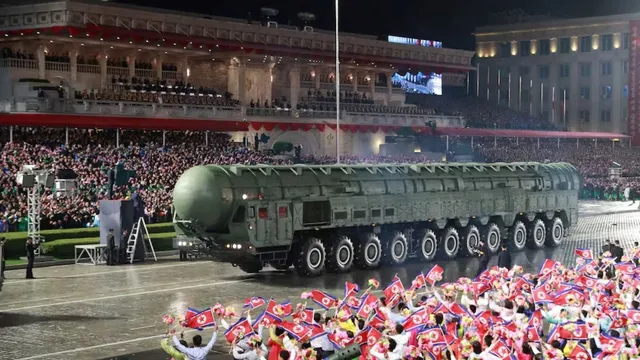- By Supratik Das
- Sat, 11 Oct 2025 08:07 PM (IST)
- Source:JND
North Korea launched its newest and strongest intercontinental ballistic missile (ICBM), the Hwasong-20, in a military parade celebrating the 80th anniversary of the ruling Workers’ Party. The event, which was witnessed by the highest-ranking Russian and Chinese officials, showcased the nation's expanding military ambitions as tensions in the region grow.
The parade in Pyongyang, the capital, showcased a variety of advanced weapons systems such as long-range strategic cruise missiles, unmanned aerial vehicle launch vehicles, and ground-to-air and ground-to-ground missiles. But special prominence was given to the Hwasong-20 ICBM, which North Korean state media described as its “most powerful nuclear strategic weapon system.”
What Is The Hwasong-20 Missile?
Mounted on 11-axle launcher trucks, the missile was revealed only weeks after North Korea tested a new solid-fuel rocket engine built with carbon fibre, capable of generating 1,971 kilonewtons of thrust.
• Multiple Warhead Capability: The longer, more bulbous nose of the missile indicates it may carry MIRVs (Multiple Independently Targetable Re-entry Vehicles), enabling a single missile to strike multiple targets and penetrate sophisticated missile defence systems.
• Range and Reach: Projected operational range of 15,000 km, theoretically sufficient to target any point in the continental United States.
• Engine and Propulsion: Driven by a solid-fuel engine constructed from carbon-fiber-reinforced composites, producing 1,971 kilonewtons of thrust—more powerful than previous North Korean engines.
• Mobility: Deployed on 11-axle mobile launcher trucks, facilitating quick deployment and raising survivability against preemptive strikes.
• Advanced Guidance System: Presumably combines inertial navigation, home GPS, and optical sensors for greater precision.
North Korea marked the 80th anniversary of its ruling party with a major military parade overseen by Kim Jong Un, showcasing a new Hwasong-20 intercontinental ballistic missile, said to be its most powerful yet. pic.twitter.com/xmVzIs2r67
— Clash Report (@clashreport) October 11, 2025
• Re-entry Considerations: Carbon-fiber build allows to resist heat upon atmospheric re-entry, though analysts are wary of the warhead survivability of the missile at distances.
• Quick Launch Readiness: Solid-fuel configuration enables quick launch without cryogenic fueling, thus improving deterrent capability.
• Strategic Role: Part of North Korea's twin strategy to develop both nuclear and conventional military capability, putting more leverage on the United States and its allies.
What's Ahead?
Russian Security Council deputy head Dmitry Medvedev, Chinese Premier Li Qiang, and Vietnam’s leader To Lam attended the parade alongside Kim. Medvedev expressed gratitude for North Korea’s military support in Russia’s Ukraine campaign, while Kim reaffirmed his hopes to strengthen cooperation with Russia.
In his address, Kim Jong Un referred to North Korea as a "reliable member of the socialist forces" and "a pillar of independence" against Western domination. He declared, "Today, we stand before the world as a powerful people with no impediment we cannot surmount and no great success we cannot attain," solidifying Pyongyang's theme of military and political endurance.
ALSO READ: ‘Hamburgers, Ice Cream’ Banned In North Korea? Inside Kim Jong Un’s Latest Crackdown
The parade highlights the regime's twin approach to developing its conventional military strength while demonstrating its nuclear deterrence. With Russian and Chinese officials present, the parade also indicates possible strengthening of strategic alliances within Northeast Asia, tipping the current power dynamics in the region.

